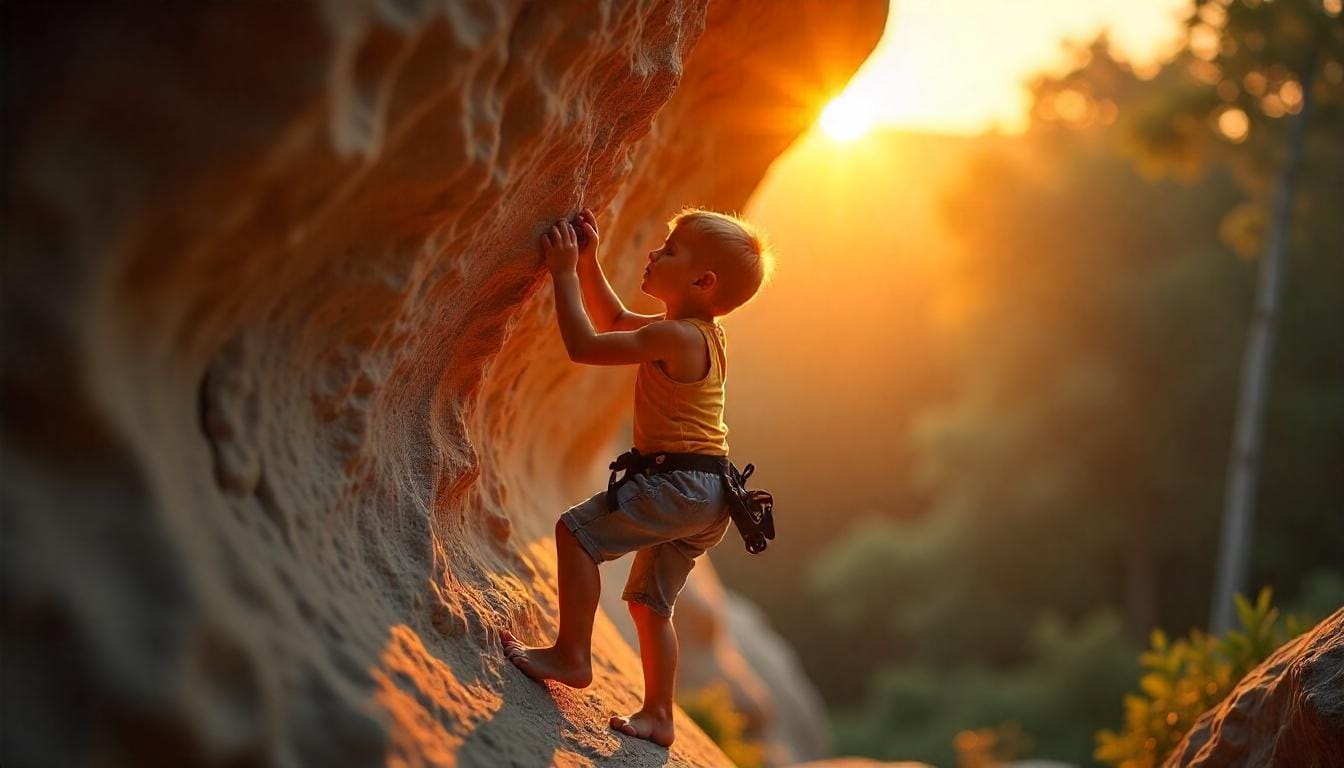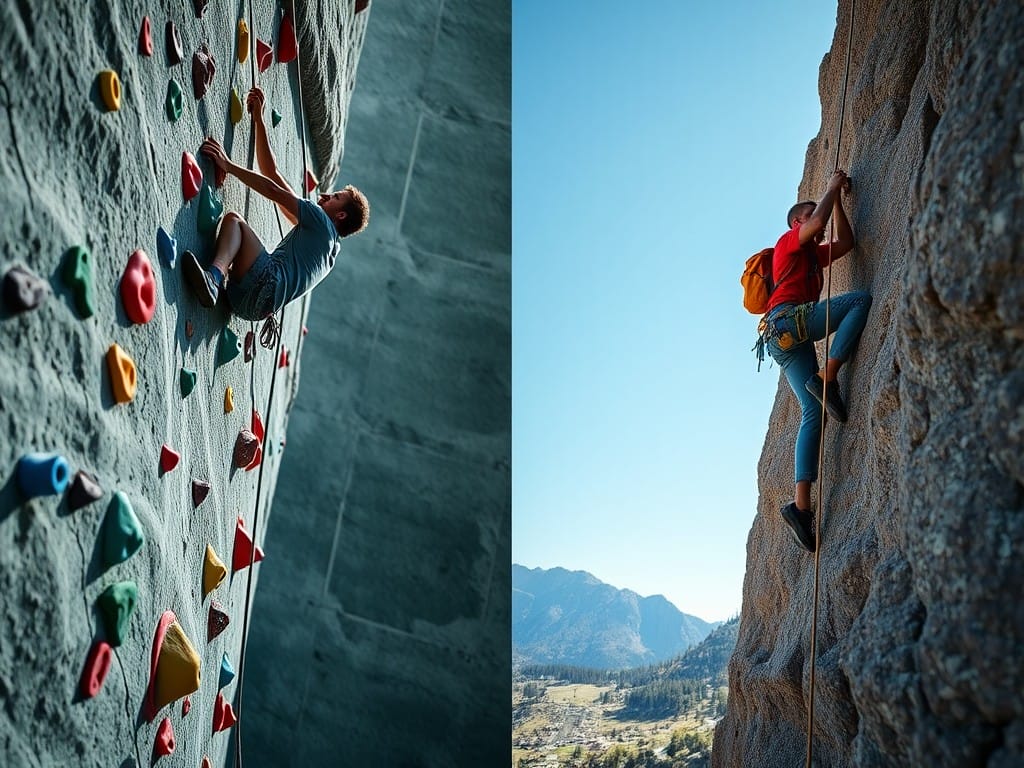Bouldering vs Rock Climbing: Learn the differences, benefits, and which one suits beginners best. Get ready to start climbing with the right choice!
Outdoor enthusiasts often ponder the differences between bouldering and rock climbing. Both deliver thrills, yet each activity has its own appeal. Bouldering involves climbing short walls without ropes. Rock climbing can utilize ropes for safety on taller climbs.
Those curious about which pastime seems more enjoyable or manageable may find the unique perks and challenges of each sport outlined here worthwhile. Comparing key facets of bouldering and rock climbing can help outdoor lovers select their next adventure.
Keep reading to learn more about the differences and benefits of these two popular pursuits.
Key Takeaway
- Bouldering is a rope-free climbing style, focusing on short climbs.
- Rock climbing includes various styles, such as top roping and lead climbing.
- Both activities provide great health benefits and fun experiences.
Bouldering vs Rock Climbing
Bouldering and rock climbing are both really fun ways to go climbing. With bouldering, people climb shorter walls that are usually no more than 20 feet tall. The climbers do not use ropes. Instead, they use thick mats called crash pads on the ground below. These pads make a soft landing in case the climber falls off the wall. Even though the climbs can be tricky, the crash pads make bouldering feel a little safer. [1]
On the other hand, rock climbing walls can be much taller. For safety, rock climbers often use ropes. A belayer is a person who holds the rope to protect the climber. If the climber slips, the belayer catches them with the rope. This makes rock climbing a great choice for those who want to climb really high.
Each style has its own challenges. Bouldering needs power and quick thinking because climbers have to figure out the best way up the wall. Rock climbing requires endurance and good footwork because climbers spend more time on the tall walls.
Bouldering vs Top Roping
With top roping, the climber is tied to a rope anchored at the top of the wall. This keeps them safe. If they fall, the belayer will catch them with the rope. Top roping is great for beginners learning to climb. It helps them feel secure and not worry about falling. They can focus on practicing climbing moves. [2]
Bouldering is different. It uses less gear – just climbing shoes and chalk for the hands. The chalk helps keep climbers’ hands dry so they can grip the holds. When bouldering, climbers fall onto thick crash pads on the ground. This makes it easier to get back up and try the climb again after a fall. Bouldering can be tougher since it takes a lot of strength and skill. Those new to climbing might find it intimidating at first. But many climbers find that with practice, they gain confidence very quickly!
Bouldering vs Lead Climbing
Lead climbing is another style that uses ropes too. As the climber goes up the wall, they attach the rope to clips called quickdraws. If the climber falls, they may drop a short way before the rope catches them. This can feel scary! With bouldering, climbers stay close to the ground. So they can focus on short climbs without worrying about big falls.
Both lead climbing and bouldering challenge the body in different ways. Lead climbing builds endurance because the climbs are longer. It also takes mental focus since the climber has to place their own gear as they go. Bouldering builds power and skill over short distances instead. It requires climbers to think fast about reaching the next hold.
Benefits of Bouldering
Bouldering is a super fun way to get fit. Here are some of the benefits:
- Strength Building: Climbers build upper body and core strength. This helps with overall fitness and other activities.
- Problem-Solving: Bouldering helps climbers carefully think through their moves. They have to figure out the best way up, which can be a mental challenge.
- Accessibility: Bouldering needs little gear and can be done indoors. Many cities have climbing gyms, making it easy to start.
- Social Fun: Bouldering gyms often create a friendly community. People support each other, share tips, and make new friends.
Types of Climbing
There are a bunch of different types of climbing:
Bouldering – This is climbing short walls without ropes. Bouldering helps build strength and climbing skills.
- Top Roping – With top roping, the rope is anchored at the top for safety. Top roping is great for beginners learning to climb.
- Lead Climbing – Lead climbers attach gear to the wall themselves as they climb up. Lead climbing requires more focus and skill.
- Sport Climbing – This is kind of like lead climbing. But sport routes have pre-set bolts already in the wall for protection.
- Trad Climbing – With traditional or “trad” climbing, the climber places all their own gear in cracks in the rock. Trad climbing requires a lot of experience.
Climbing Styles
Climbing styles can be different based on technique and where you climb. Some examples are:
- Indoor vs. Outdoor – Indoor climbing is in controlled gyms. Outdoor climbing is on real rock faces outside. Outdoor can be more challenging.
- Dynamic vs. Static Moves – Dynamic moves are fast and explosive to reach holds. Static moves are carefully balanced to conserve energy.
Is Bouldering Harder?
Some people think bouldering is harder because it requires a lot of strength and skill. Those new to climbing might struggle at first with the tricky moves. However, the climbs are short with bouldering. This means beginners get quick feedback. They can try again right away and learn fast from their mistakes. For those afraid of heights, top roping may feel safer. The rope secured above keeps them protected.
What feels hard or easy is different for each person. It depends on their strengths. The important thing is to start slow and keep practicing. Over time, climbers get better and can take on new challenges. The great thing about climbing is that anyone can improve with focus and persistence!
Bouldering Popularity

Lots of people love bouldering because it is so popular and easy to start. More and more climbing gyms are opening up. This makes bouldering easy to access for everyone.
Bouldering is also social and fun. Climbers like cheering each other on and making new friends. Completing a tough boulder problem gives a quick feeling of success. Many find this very exciting!
Overall, bouldering is a great way to challenge yourself and meet people in a supportive place. The community helps beginners feel welcomed. With practice, bouldering skills improve quickly. It just takes persistence and a positive attitude!
Beginner Climbing Comparisons
For people just starting out, here are some things to think about:
- Bouldering is easier to begin with. It needs less equipment and no partner. Climbers can go solo and still have lots of fun.
- Top roping feels more secure for those nervous about heights. The anchored rope lets beginners focus on learning without fear.
- Lead climbing can be more difficult. It’s best for climbers with experience who want bigger challenges. Lead requires more skills and confidence.
The most important thing is to start slow and keep trying! Set goals, practice regularly, and celebrate small wins. Climbing takes persistence but the rewards are huge. With time and effort, beginners will gain skills and courage on the wall.
FAQ
How does top rope climbing differ from bouldering in terms of safety gear and protective gear?
When you’re top rope climbing, you need a climbing rope, belay device, and a climbing partner who manages your safety. Bouldering only requires a crash pad to cushion potential falls. Both styles use climbing chalk and chalk bags, but the key differences in gear reflect their distinct safety approaches.
What makes bouldering a more popular form of climbing compared to traditional rock climbing?
Bouldering’s appeal lies in its accessibility and short bursts of intense climbing. You don’t need as much climbing gear or a climbing partner to get started. Many climbing gyms offer bouldering walls, making it easier to practice. The social aspect of solving boulder problems with others adds to its draw.
Can you explain how the grading systems differ between bouldering and other types of climbing?
Bouldering uses the Font scale in Europe and the V-scale in the United States, while roped climbing employs the Yosemite Decimal System. These rating systems measure different aspects – bouldering grades focus on move difficulty in a short sequence, while climbing grades consider endurance over longer routes.
What role does body tension and finger strength play in both climbing styles?
Both styles demand grip strength and dynamic movement, but bouldering typically requires more intense body tension and finger strength due to its powerful, explosive nature. Rock climbing on high walls needs more endurance to maintain these physical demands over longer climbing routes.
How did pioneers like John Gill influence the development of free climbing and free soloing?
John Gill revolutionized climbing by introducing gymnastic movements to bouldering. His influence spread across the United States, impacting both free climbing and free soloing. His techniques changed how climbers approach outdoor rock and helped establish bouldering as a distinct form of climbing.
What’s the difference between climbing at indoor climbing walls versus outdoor rock formations?
Indoor climbing at a climbing gym offers controlled environments where route setters create specific challenges. Outdoor rock climbing on natural rock face presents unique challenges with varying rock formations. While indoor walls are great for learning, outdoor rock provides a more adventurous experience.
How do aid climbing and big wall climbing compare to bouldering?
Aid climbing and big wall climbing involve using gear to ascend massive rock faces, often requiring multiple days. Bouldering focuses on short, intense problems close to the ground. These forms of climbing need different mental game approaches and physical preparations.
What should beginners know about essential climbing gear for both styles?
Basic bouldering needs include climbing pants, climbing chalk, and a crash pad. Rock climbing requires more gear: climbing rope, belay device, and an invisible cord for safety. Companies like Black Diamond make gear for both styles, but you’ll spend more initially on rope climbing equipment.
What resources do climbers use to find routes and boulder problems?
Mountain Project serves as a popular platform where rope climbers and boulderers share information about climbing routes and boulder problems. The community contributes details about locations from South Africa to local spots in the United States.
How does speed climbing differ from bouldering and traditional wall climbing?
Speed climbing happens on standardized climbing routes with specific heights. Unlike bouldering’s creative problem-solving or traditional rock climbing’s varied approaches, speed climbing focuses purely on ascending a predetermined route as quickly as possible.
Conclusion
In summary, bouldering and rock climbing both provide exciting ways to climb. Each has special benefits and challenges. Beginners can find enjoyment in either, based on what they like. Bouldering focuses on short climbs using power. Rock climbing offers more styles to try out. The key is to start small, practice regularly, and have fun growing your skills!
References
- https://climbontherocks.com/blogs/rock-climbing-blog/bouldering-vs-rock-climbing-comparing-the-two-types-of-climbing
- https://recsports.tamu.edu/whats-the-difference-climbing-bouldering/






